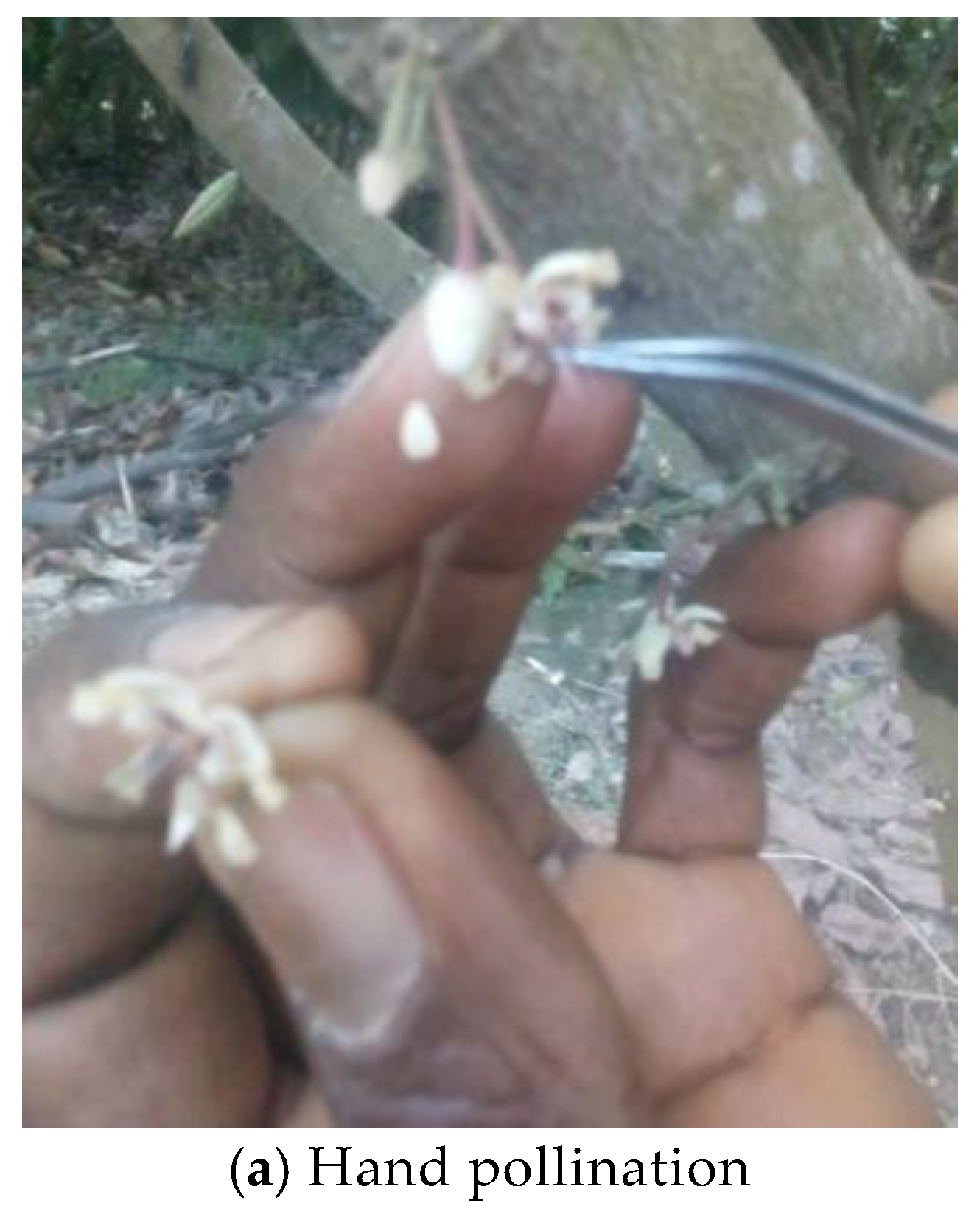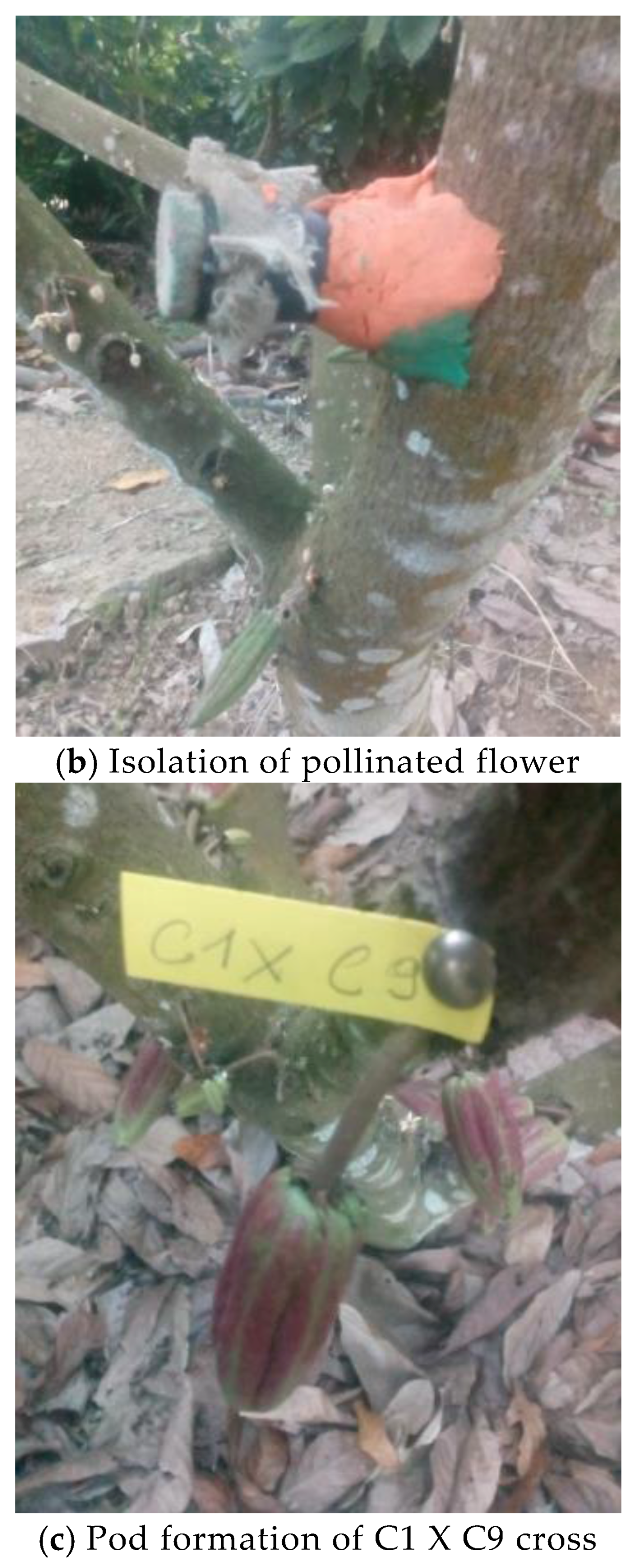Compatibility of Ten Elite Cocoa (Theobroma cacao L.) Clones
Abstract
:1. Introduction
2. Materials and Methods
2.1. Site
2.2. Plant Material
2.3. Experimental Design and Cultural Practices
2.4. Data Collection
2.5. Data Analysis
3. Results
3.1. Pollination Success
3.2. Compatibility of Cocoa Clones
3.2.1. Self-Compatible Clones
3.2.2. Inter-Compatible Clones
4. Discussion
5. Conclusions
Acknowledgments
Author Contributions
Conflicts of Interest
References
- Alverson, W.S.; Whitlock, B.A.; Nyffeler, R.; Bayer, C.; Baum, D.A. Phylogeny of the core Malvales: Evidence from ndhF sequence data. Am. J. Bot. 1999, 86, 1474–1486. [Google Scholar] [CrossRef] [PubMed]
- Miller, C.R. An integrated in vitro and greenhouse orthotropic clonal propagation system for Theobroma cacao L. Ph.D. Thesis, The Graduate School College of Agricultural Sciences, The Pennsylvania State University, State College, PA, USA, 2009. [Google Scholar]
- Ávila-Lovera, E.; Coronel, I.; Jaimez, R.; Urich, R.; Pereyra, G.; Araque, O.; Chacon, I.; Tezara, W. Ecophysiological traits of adult trees of Criollo cocoa cultivars (Theobroma cacao L.) from a germplasm bank in Venezuela. Exp. Agric. 2015, 52, 137–153. [Google Scholar] [CrossRef]
- Ollerton, J.; Winfree, R.; Tarrant, S. How many flowering plants are pollinated by animals? Oikos 2011, 120, 321–326. [Google Scholar] [CrossRef]
- Billes, D.J. Pollination of Theobroma cacao L. in Trinidad B.W.I. Trop. Agric. Trinidad 1942, 18, 151–156. [Google Scholar]
- Lopes, U.V.; Monteiro, W.R.; Pires, J.L.; Clément, D.; Yamada, M.M.; Gramacho, K.P. Cacao breeding in Bahia, Brazil-strategies and results. Breed. Appl. Biotechnol. 2011, 11, 73–81. [Google Scholar] [CrossRef]
- Lachenaud, P.; Mossu, G. Etude comparative de l´influence de deux modes de conduite sur les facteurs du rendement d´une cacaoyère. Café Cacao Thé 1985, 29, 21–30. [Google Scholar]
- Massaux, F.; Tchiendji, C.; Misse, C.; Decazy, B. Etude du transport du pollen de cacaoyer par marquage au 32P. Café Cacao Thé 1976, 20, 163–170. [Google Scholar]
- Bartley, B.G. The Genetic Diversity of Cacao and Its Utilization; CABI Publishing: Cambridge, MA, USA, 2005. [Google Scholar]
- Young, A.M.; Erickson, E.H.; Strand, M.A.; Erickson, B.J. Pollination biology of Theobroma and Herrania (Sterculiaceae) I. Floral biology. Insect Sci. Appl. 1987, 8, 151–164. [Google Scholar] [CrossRef]
- Parvais, J.P.; Reffye, P.; Lucas, P. Observations sur la pollinisation libre chez Theobroma cacao analyse mathématique des données et modélisation. Café Cacao Thé 1977, 21, 253–262. [Google Scholar]
- Reffye, P.; Parvais, J.P.; Mossu, G.; Lucas, P. Influence des aléas de la pollinisation sur les rendements du cacaoyer modèle mathématique et simulation. Café Cacao Thé 1978, 22, 254–274. [Google Scholar]
- Alvim, P.T. Flowering of cocoa. Cocoa Growers’ Bull. 1984, 35, 23–31. [Google Scholar]
- Aneja, M.; Gianfagna, T.; Ng, E. The roles of abscisic acid and ethylene in the abscission and senescence of cocoa flowers. Plant Growth Regul. 1999, 27, 149–155. [Google Scholar] [CrossRef]
- Irizarry, H.; Riviera, E. Early yield of five cacao families at three locations in Puerto Rico. J. Agric. Univ. Puerto Rico 1998, 82, 163–171. [Google Scholar]
- Falque, M.; Vincent, A.; Vaissiere, B.E.; Eskes, A.B. Effect of pollination intensity on fruit and seed set in cacao (Theobroma cacao L.). Sex. Plant Reprod. 1995, 8, 354–360. [Google Scholar] [CrossRef]
- Bos, M.M.; Veddeler, D.; Bogdanski, A.K.; Klein, A.M.; Tscharntke, T.; Steffan-Dewenter, I.; Tylianakis, J.M. Caveats to quantifying ecosystem services: Fruit abortion blurs benefits from crop pollination. Ecol. Appl. 2007, 17, 1841–1849. [Google Scholar] [CrossRef] [PubMed]
- De Almeida, A.A.F.; Valle, R.R. Ecophysiology of the cacao tree. Braz. J. Plant Physiol. 2007, 19, 425–448. [Google Scholar] [CrossRef]
- The North American Pollinator Protection Campaign (NAPPC). Chocolate’s sweet little secret od Chain 423 Washington Street. San Francisco, CA, 2014. 94111-2339, Phone 415-362-1137, Fax 415-362-3070. Available online: www.nappc.org (accessed on 18 June 2015).
- Takayama, S.; Isogai, A. Self-incompatibility in plants. Annu. Rev. Plant Biol. 2005, 56, 467–489. [Google Scholar] [CrossRef] [PubMed]
- Chumacero de Schawe, C.; Durka, W.; Tscharntke, T.; Hensen, I.; Kessler, M. Gene flow and genetic diversity in cultivated and wild cacao (Theobroma cacao) in Bolivia. Am. J. Bot. 2013, 100, 2271–2279. [Google Scholar] [CrossRef] [PubMed] [Green Version]
- Posnette, A.F. The pollination of cacao in the Gold Coast. J. Hortic. Sci. 1950, 25, 155–163. [Google Scholar] [CrossRef]
- Voecker, O.J. The incidence of cross-pollination in cacao. In Seventh Annual Report on Cacao Research; Imperial College of Tropical Agriculture: St. Augustine, FL, USA, 1938; pp. 9–14. [Google Scholar]
- Ford, C.S.; Wilkinson, M.J. Confocal observations of late-acting self-incompatibility in Theobroma cacao L. Sex. Plant Reprod. 2012, 25, 169–183. [Google Scholar] [CrossRef] [PubMed]
- Knight, R.; Rogers, H.H. Incompatibility in Theobroma cacao. Heredity 1955, 9, 69–77. [Google Scholar] [CrossRef]
- Cope, F.W. The mechanisms of pollen incompatibility in Theobroma cacao L. Heredity 1962, 17, 157–182. [Google Scholar] [CrossRef]
- De Nettancourt, D. Incompatibility in Angiosperms; Springer: New York, NY, USA, 1977. [Google Scholar]
- Groeneveld, J.H.; Tscharntke, T.; Moser, G.; Clough, Y. Experimental evidence for stronger cacao yield limitation by pollination than by plant resources. Perspect. Plant Ecol. Evol. Syst. 2010, 12, 183–191. [Google Scholar] [CrossRef]
- Williams, J.H.; Mazer, S.J. Pollen: Tiny and ephemeral but not forgotten: New ideas on their ecology and evolution. Am. J. Bot. 2016, 103, 365–374. [Google Scholar] [CrossRef] [PubMed]
- Phillips-Mora, W.; Castillo, J.; Arciniegas, A.; Mata, A.; Sánchez, A.; Leandro, M.; Astorga, C.; Motamayor, J.; Guyton, B.; Seguine, E.; et al. Overcoming the main limiting factors of cacao production in Central America through the use of improved clones developed at CATIE. In Proceedings of the 16th International Cocoa Research Conference, COPAL, Bali, Indonesia, 16–21 November 2009; pp. 93–99. [Google Scholar]
- Lachenaud, P.; Olivier, G. Compatibility and duration of pod maturation in Guianan wild cocoa trees—Preliminary results. Ingenic Newsl. 2005, 10, 20–22. [Google Scholar]
- N’guessan, K.M.F. Etude la Compatibilité de Quinze Clones de Cacaoyer (Theobroma cacao Linné) D’intérêt Agronomique; Rapport de fin de stage de Brevet de Technicien Supérieur Option: Agronomie Tropicale; Ecole de Formation et de Recyclage Professionnel d’Abidjan: Abidjan, Côte d’Ivoire, 2010. [Google Scholar]
- Eskes, A.B.; Engels, J.M.M.; Lass, R.A. Working Procedures for Cocoa Germplasm Evaluation and Selection; IPGRI: Rome, Italy, 2000. [Google Scholar]
- SAS. Statistical Analysis System User’s Guide; SAS Institute, NC State University: Raleigh, NC, USA, 2003. [Google Scholar]
- Yamada, M.M.; Guries, R.P. Mating system analysis in cacao (Theobroma cacao L.). Agrotrópica 1998, 10, 165–176. [Google Scholar]
- Hasenstein, K.H.; Zavada, M.S. Auxin modification of the incompatibility response in Theobroma cacao. Physiol. Plant. 2001, 112, 113–118. [Google Scholar] [CrossRef] [PubMed]
- Lachenaud, P. Variations in the number of beans per pod in Theobroma cacao L. in the Ivory Coast. III. Nutritional factors, cropping effects and the role of boron. J. Hortic. Sci. 1995, 70, 7–13. [Google Scholar] [CrossRef]
- Lanaud, C.; Sounigo, O.; Amefia, Y.K.; Paulin, D.; Lachenaud, P.; Clement, D. Nouvelles données sur le fonctionnement du système d’incompatibilité du cacaoyer et ses conséquences pour la sélection. Café Cacao Thé 1987, 31, 267–277. [Google Scholar]
- Szymajda, M.; Napiórkowska, B.; Korbin, M.; Żurawicz, E. Studies on the interspecific crossing compatibility among three Prunus species and their hybrids. Hortic. Sci. (Prague) 2015, 42, 70–82. [Google Scholar] [CrossRef]


| Clones | Origin | Potential Yield (ton/ha) (2011–2015) * |
|---|---|---|
| C1 | Trinidad | 2.3 |
| C8 | Trinidad | 1.8 |
| C9 | Trinidad | 2.3 |
| C14 | Côte d’Ivoire | 2.8 |
| C15 | Côte d’Ivoire | 2.0 |
| C16 | Côte d’Ivoire | 4.0 |
| C17 | Côte d’Ivoire | 1.9 |
| C18 | Côte d’Ivoire | 1.4 |
| C20 | Côte d’Ivoire | 1.4 |
| C21 | Côte d’Ivoire | 1.6 |
| Clones | C1 | C8 | C9 | C14 | C15 | C16 | C17 | C18 | C20 | C21 |
|---|---|---|---|---|---|---|---|---|---|---|
| C1 | X * | X | X | X | X | X | X | X | X | X |
| C8 | X | X | X | X | X | X | X | X | X | |
| C9 | X | X | X | X | X | X | X | X | ||
| C14 | X | X | X | X | X | X | X | |||
| C15 | X | X | X | X | X | X | ||||
| C16 | X | X | X | X | X | |||||
| C17 | X | X | X | X | ||||||
| C18 | X | X | X | |||||||
| C20 | X | X | ||||||||
| C21 | X |
| Pollination Success (%) | |||
|---|---|---|---|
| Clones | Self-Pollination | Inter-Pollination | Mean |
| C1 | 33.33 ab * | 22.22 ab | 27.78 |
| C8 | 33.33 ab | 16.30 abcd | 24.82 |
| C9 | 53.33 a | 24.07 a | 38.70 |
| C14 | 16.67 bc | 21.48 ab | 19.08 |
| C15 | 33.33 ab | 14.82 bcd | 24.98 |
| C16 | 3.33 c | 17.78 abcd | 10.56 |
| C17 | 30.00 ab | 19.63 abc | 24.82 |
| C18 | 3.33 c | 14.44 bcd | 8.89 |
| C20 | 13.33 bc | 9.63 d | 11.48 |
| C21 | 36.67 ab | 12.22 cd | 24.45 |
| Means | 25.67 | 17.26 | 21.47 |
| P | 0.0024 | 0.0015 | |
| CV | 50.80 | 79.18 | |
© 2017 by the authors. Licensee MDPI, Basel, Switzerland. This article is an open access article distributed under the terms and conditions of the Creative Commons Attribution (CC BY) license (http://creativecommons.org/licenses/by/4.0/).
Share and Cite
N’Zi, J.-C.; Kahia, J.; Diby, L.; Kouamé, C. Compatibility of Ten Elite Cocoa (Theobroma cacao L.) Clones. Horticulturae 2017, 3, 45. https://doi.org/10.3390/horticulturae3030045
N’Zi J-C, Kahia J, Diby L, Kouamé C. Compatibility of Ten Elite Cocoa (Theobroma cacao L.) Clones. Horticulturae. 2017; 3(3):45. https://doi.org/10.3390/horticulturae3030045
Chicago/Turabian StyleN’Zi, Jean-Claude, Jane Kahia, Lucien Diby, and Christophe Kouamé. 2017. "Compatibility of Ten Elite Cocoa (Theobroma cacao L.) Clones" Horticulturae 3, no. 3: 45. https://doi.org/10.3390/horticulturae3030045






